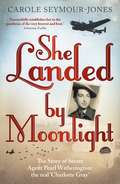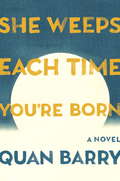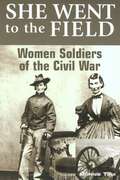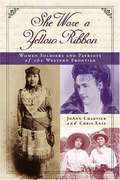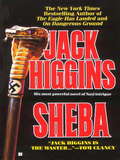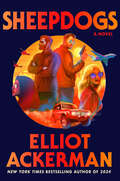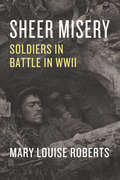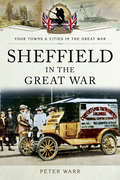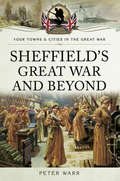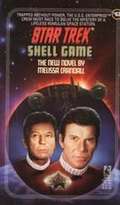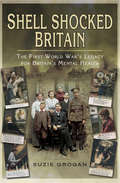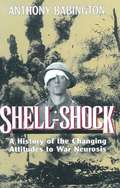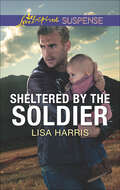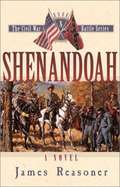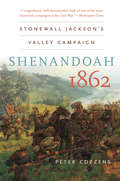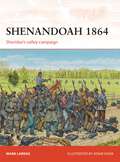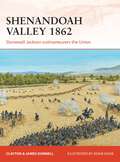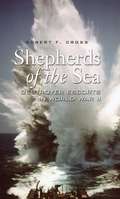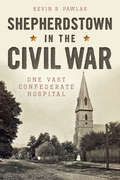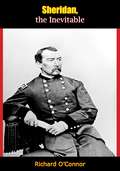- Table View
- List View
She Landed By Moonlight: The Story of Secret Agent Pearl Witherington: The 'Real Charlotte Gray'
by Carole Seymour-JonesOn the night of the 22 September 1943 Pearl Witherington, a twenty-nine-year-old British secretary and agent of the Special Operations Executive (SOE), was parachuted from a Halifax bomber into Occupied France. Like Sebastian Faulks' heroine, Charlotte Gray, Pearl had a dual mission: to fight for her beloved, broken France and to find her lost love. Pearl's lover was a Parisian parfumier turned soldier, Henri Cornioley, who had been taken prisoner while serving in the French Logistics Corps and subsequently escaped from his German POW camp. Agent Pearl Witherington's wartime record is unique and heroic. As the only woman agent in the history of SOEs in France to have run a network, she became a fearless and legendary guerrilla leader organising, arming and training 3,800 Resistance fighters. Probably the greatest female organiser of armed maquisards in France, the woman whom her young troops called 'Ma Mère', Pearl lit the fires of Resistance in Central France so that Churchill's famous order to 'set Europe ablaze', which had brought SOE into being, finally came to pass. Pearl's story takes us from her harsh, impoverished childhood in Paris, to the lonely forests and farmhouses of the Loir-et-Cher where she would become a true 'warrior queen'. Shortly before Pearl's death in 2008, the Queen presented her with a CBE in Paris. While male agents and Special Force Jedburghs received the DSO or Military Cross, an ungrateful country had forgotten Pearl. She had been offered a civilian decoration in 1945 which she refused, saying 'There was nothing civil about what I did.' But what pleased her most was to receive her Parachute Wings, for which she had waited over 60 years. Two RAF officers travelled to her old people's home and she was finally able to pin the coveted wings on her lapel. Pearl died in February 2008 aged 93.
She Weeps Each Time You're Born: A Novel (Vintage Contemporaries)
by Quan BarryQuan Barry's luminous fiction debut brings us the tumultuous history of modern Vietnam as experienced by a young girl born under mysterious circumstances a few years before the country's reunification, a child gifted with the otherworldly ability to hear the voices of the dead. At the peak of the war in Vietnam, a baby girl is born along the Song Ma River on the night of the full moon. This is Rabbit, who will journey away from her destroyed village with a makeshift family thrown together by war. Here is a Vietnam we've never encountered before: through Rabbit's inexplicable but radiant intuition, we are privy to an intimate version of history, from the days of French Indochina and the World War II rubber plantations through the chaos of postwar reunification. With its use of magical realism--Rabbit's ability to "hear" the dead--the novel reconstructs a turbulent historical period through a painterly human lens. This is the moving story of one woman's struggle to unearth the true history of Vietnam while simultaneously carving out a place for herself within it.From the Hardcover edition.
She Went to the Field: Women Soldiers of the Civil War
by Bonnie TsuiThis exciting new volume profiles several substantiated cases of female soldiers during the American Civil War, including Sarah Rosetta Wakeman (aka Private Lyons Wakeman, Union); Sarah Emma Edmonds (aka Private Frank Thompson, Union); Loreta Janeta Velazquez (aka Lieutenant Harry T. Buford, Confederate); and Jennie Hodgers (aka Private Albert D. J. Cashier, Union). Also featured are those women who may not have posed as male soldiers but who nonetheless pushed gender boundaries to act boldly in related military capacities, as spies, nurses, and vivandieres ("daughters of the regiment") who bore the flag in battle, rallied troops, and cared for the wounded.Examining the Civil War through the lens of these women soldiers who fought in the conflict offers valuable insight on existing historical work. This volume will acquaint readers with these women, offering in-depth biographies and behind-the-scenes information. While drawing from recent academic work, Women Soldiers of the Civl War is a lively text geared toward the general-audience reader.
She Wore a Yellow Ribbon: Women Soldiers and Patriots of the Western Frontier
by Chris Enss Joann ChartierThis book profiles a dozen women whose courage went beyond what the authors call the "usual, everyday" variety required in the early days of the American West. It includes US and Mexican women who provide differing views of the battle of the Alamo. The title stems from the story of Buffalo Soldier Cathy Williams, who served in the US military in the 1860s disguised as a man, but later wore a yellow ribbon to show pride in her gender. Annotation © 2004 Book News, Inc., Portland, OR (booknews.com)
She's Far From Hollywood
by Jo Mcnally"You and me are a bad idea, Hollywood." She's a former beauty queen, former reality TV star and the former wife of a former Sexiest Man Alive. And now Bree Mathews has been forced into hiding on this godforsaken farm in the middle of Nowhere, North Carolina...all because some deranged stalker wants her dead. That grumpy farmer next door isn't enough to chase her back to Malibu, even with his dark and scary PTSD episodes from his army days and his lack of respect for all things Hollywood. Always up to a challenge, she sets out to prove to Cole "Plowboy" Caldwell that you can never judge a celebrity on the lam by her cover!
Sheba
by Jack HigginsJack Higgins's most exciting novel of World War II intrigue since his smash bestseller The Eagle Has Landed.The lost Temple of Sheba is not just a biblical legend.A German archaeologist has found it. The Nazis have claimed it.<P><P>And one American explorer has stumbled upon their secret--a plot that could change the course of World War II...The year is 1939. An American archaeologist named Gavin Kane is asked to help a woman search for her missing husband. When Kane follows the man's trail into the ruthless desert of Southern Arabia, he makes two shocking discoveries. One is the legendary Temple of Sheba, an ancient world as fantastic as King Solomon's mines. The other is a band of Nazi soldiers who plan to turn the sacred landmark into Hitler's secret stronghold...
Sheena's Promise: A heartwarming and emotional Scottish saga, set in World War Two (Kiltie Street Girls)
by Carol MacleanCan she fix her family before the war is over? When Eileen, known to all as Sheena, is forced to move back to Kiltie Street from Devon by her landlady, she is unsure how she will start over again. With the help of friends old and new, she finds work at a garment factory. And though she catches the eye of some local men, her fiancé, Jimmy, overseas is never far from her mind. As life settles in, a surprise appears at Sheena’s door: a woman named Amy, claiming to be her cousin. Amy has strange habits and a frantic personality - but Sheena agrees to house her for the time being. However, her suspicions grow around Amy’s secretive ways, especially when Jimmy returns from war, and Amy refuses to leave the newlyweds. With war coming to a close, Amy is hiding more than Sheena imagined. With help from the rest of the Kiltie Street girls, can Sheena find a way to mend their differences, and be a family once again? A romantic and gripping World War Two Scottish saga that fans of Rosie Meddon and Rowena Summers will adore. Readers are loving The Kiltie Street Girls saga series: 'This series just gets better and better...I didn't want it to end. I'm already looking forward to reading the next book by Carol.' ***** Reader Review ‘Fantastic characters, great setting, I was hooked and devoured this book in one sitting…was sad to finish it and keep thinking about the characters.’ ***** Reader Review ‘WOW. Loved this book. If you love family saga based in the war, you will love this.’ ***** Reader Review ‘Brilliant book – family saga at its best. I love the characters; you feel you are part of the story.’ ***** Reader Review ‘Fantastic characters, great setting, I was hooked and devoured this book in one sitting…was sad to finish it and keep thinking about the characters.’ ***** Reader Review ‘A great WWII-era historical fiction saga… I truly enjoyed this one… Through this story of love, loss, uncertainty, and finding one’s place in life we also get a glimpse of history as well… Beautifully written.’ ***** Reader Review
Sheepdogs: A Novel
by Elliot AckermanTwo Misfits. One Mission. Zero Back-Up. • When a high-stakes heist goes wrong, an ex-CIA operative and a special operations pilot find themselves in the middle of a game of espionage and survival as they navigate a treacherous web of deception and shifting loyalties in a globe-spanning, action-packed thriller from the New York Times bestselling author of 2034. "Move Sheepdogs to the top of your list!&”—Jack Carr, #1 New York Times bestselling author &“A thriller and comedy in one, it&’s a wild ride.&”—Harlan Coben, #1 New York Times bestselling authorSkwerl and Cheese are down on their luck and about to find themselves tangled in the heist of their lives. Skwerl, once an elite member of the CIA's paramilitary unit, was cast out after a raid gone wrong in Afghanistan. Big Cheese Aziz, a former Afghan pilot of legendary skill, now works the graveyard shift at a gas station.Recruited into a shadowy network of "sheepdogs," they embark on a mission to repossess a multi-million-dollar private jet stranded on a remote African airfield. But as they wind through a labyrinth of lies and hidden agendas, they discover that nothing is as it seems. Their contact vanishes, their handler's motives are suspect, and the true source of their payday remains a mystery.With the stakes skyrocketing and the women in their lives drawn into the fray, this unlikely spy duo find themselves deep in the underbelly of modern war and intelligence.From the jungles of Kampala to the glitz of Marseille, they'll need to be as cunning as they are bold to survive in a game where the line between the hunters and the hunted is razor-thin.
Sheer Misery: Soldiers in Battle in WWII
by Mary LouiseMarching across occupied France in 1944, American GI Leroy Stewart had neither death nor glory on his mind: he was worried about his underwear, which was engaged in a relentless crawl of its own. Similar complaints of physical discomfort pervade infantrymen’s memories of the European theater, whether the soldiers were British, American, German, or French. Wet, freezing misery with no end in sight—this was life for millions of enlisted men during World War II.Sheer Misery trains a humane and unsparing eye on the corporeal experiences of the soldiers who fought in Belgium, France, and Italy during the last two years of the war. In the horrendously unhygienic and often lethal conditions of the front line, their bodies broke down, stubbornly declaring their needs for warmth, rest, and good nutrition. Feet became too swollen to march, fingers too frozen to pull triggers; stomachs cramped, and diarrhea stained underwear and pants. Turning away from the accounts of high-level military strategy that dominate many WWII chronicles, acclaimed historian Mary Louise Roberts instead relies on diaries and letters to bring to life visceral sense memories like the moans of the “screaming meemies,” the acrid smell of cordite, and the shockingly mundane sight of rotting corpses. As Roberts writes, “For soldiers who fought, the war was above all about their bodies.”
Sheffield in the Great War (Your Towns & Cities in the Great War)
by Peter WarrThis fascinating new book is devoted to an almost unknown period in the history of Sheffield. It sets the city's people and events against a background of key national developments by looking also at the way government regulations were tightened, how the country's morale was maintained, and how industry was encouraged to deliver more output.Sheffield in the Great War is written for the general reader, and a large number of the city's residents, companies and streets are mentioned by name. Many aspects of life and work are described and illustrated with more than one hundred original photographs. Numerous advertisements and excerpts are presented from the city's wartime newspapers, and highlighted Display Boxes in every chapter summarize particularly interesting or quirky themes. For more specialist readers, Notes at the end of the book provide additional detail and links to other publications and websites; general readers can of course ignore those. Two substantial Indexes make it easy to find personally-relevant people, topics and places.The book thus offers to the general reader an easy-to-read narrative with many pictures, and it provides a valuable source of information and reference to those who would like to learn more. Sheffield in the Great War starts with a brief account of the conflict itself, looking at its enormous cost not only in terms of money but also in thousands and thousands of men and horses killed or disabled. Next it presents short reviews of Britain and the city in 1914 to introduce national features which became important in wartime Sheffield. The following chapters describe Sheffield life in the four and a half years of war, with special attention to recruiting and the creation of more than twenty new military hospitals. Huge numbers of people devoted themselves to voluntary work, and the book includes much information that has been lost for the past hundred years.
Sheffield's Great War and Beyond, 1916–1918: 1916-1918 (Your Towns & Cities in the Great War)
by Peter WarrThis book is out of the ordinary. As well as describing the many changes in Sheffield between 1914 and 1918, it tells about the troubling events in following years as poverty and riots took hold.It is also special in identifying hundreds of small as well as large Sheffield companies that worked to provide the necessities of war. With many previously-hidden facts, the book describes the city's 'national factories', the new Ministry of Munitions, the government's control of companies, arguments about the employment of women, an increased emphasis on workers' welfare, the impact of the Sheffield Committee on Munitions of War, and the special contributions of the Cutlers' Company.Compulsory call-up, conscientious objectors and the work of the Sheffield Military Tribunal are also brought to life, as are problems caused by a shortage of food and the eventual imposition of rationing. The city's German prisoners of war are introduced, as are the ravages of influenza and the terrible poverty and conflict that soon afflicted the city. These local changes are presented against a background of important national events and with more than 100 original photographs.
Sheffield's Military Legacy (Military Legacy)
by Gerry van TonderIn the century following the Norman invasion, a castle was built at the confluence of the rivers Sheaf and Don, an early recognition of Sheffields strategic importance. Destroyed in the thirteenth century during the Second Barons War, a second castle was built on the site, but in 1647, it was ordered to be demolished immediately after the cessation of the Civil War, thereby negating any future tactical use by either Parliamentarian or Royalist.Steel production and downstream manufacturing would, however, be perpetually embedded in the military legacy of this seat of industrial innovation and production. The Vickers steel foundry was established in Sheffield in 1828. Following the manufacture of the factorys first artillery in 1890, Sheffield expanded to find itself a leading supplier in the First World War, feeding the military with shells, artillery, naval guns, armor plating, aircraft parts, torpedoes, helmets and bayonets. Sheffields contribution to the British war machine in the Second World War quickly attracted the attention of Nazi Germany. In December 1940, in an operation appropriately code-named Schmelztiegel, or Crucible, Sheffield suffered two major raids aimed primarily at steel and munitions factories.A proud tradition of answering a call to the colors spawned the 84th Regiment of Foot, the Loyal Independent Sheffield Volunteers of the 1700s, the Hallamshire Rifle Volunteers raised in 1859, and the Sheffield Squadron, Yeomanry Cavalry. The 18991902 Anglo-Boer War would also have an enduring legacy: the Sheffield Wednesday football stadium was named Spioen Kop, while local road names include Ladysmith Avenue and Mafeking Place. On 1 July 1916, the Sheffield City Battalion fought in an heroic and costly, but hopeless, action on the Somme to capture the village of Serre. Through the Second World War right up to Afghanistan, Sheffields men and women in uniform have not been found wanting.Sheffields rich military legacy portrayed in this publication is drawn from a cross section of representative units, home and foreign actions, uniformed personalities, barracks at the hub of musters, the caliber of gallantry including six Victoria Crosses as well as the immortality of names on memorials, such as the Sheffield Memorial Park in France.
Shell Game (Star Trek: The Original Series #63)
by Melissa CrandallShell Game While on the routine mission to retrieve a research drone for recycling, the U.S.S. Enterprise encounters a Romulan space station adrift within Federation borders. Exploring the lifeless station, the crew finds ghostly apparitions flitting at the edges of sight. Soon the U.S.S. Enterprise is also inexplicably without power. Captain Kirk and his crew must now solve the mystery of the strange apparitions before the Starship suffers the station's fate. The situation becomes desperate when a Romulan warship arrives looking for the station, and the Romulan Commander accuses the Federation of treachery. Before Captain Kirk can save the Starship Enterprise from complete destruction, he must avoid becoming drawn into a deadly shell game -- a game that will leave no winners and no survivors...
Shell Shocked Britain: The First World War's Legacy for Britain's Mental Health
by Suzie GroganWe know that millions of soldiers were scarred by their experiences in the First World War trenches, but what happened after they returned home? Suzie Grogan reveals the First World War's disturbing legacy for soldiers and their families. How did a nation of broken men, and 'spare' women cope? In 1922 the British Parliament published a report into the situation of thousands of 'service patients', or mentally ill ex-soldiers still in hospital. What happened to these men? Were they cured? What treatments were on offer? And what was the reception from their families and society? Drawing on a huge mass of original sources, Suzie Grogan answers all those questions, combining individual case studies with a narrative on wider events. Unpublished material from the archives shows the true extent of the trauma experienced by the survivors. This is a fresh perspective on the history of the post-war period, and the plight of a traumatised nation.
Shell-Shock: A History of the Changing Attitudes to War Neurosis
by Anthony BabingtonAs Anthony Babington is careful to point out in his forwrd, this is not a medical book. It is, rather, a distillation, in words which any layman can understand, of the long struggle by the medical profession, and by influencail civilians of an understanding frame of mind, to persudae the Service Chiefs, in particuliar Senior army pfficers, that soldiers can only stand so much fighting. In the First World War, as Babington points out, men were shot at dawn for cowardice or desertion. One can only wonder that many more didn't crack up under the appalling stress to which they were subjected. By 1939 the situation had improved, and of course the Second World War was a much more mobile affair, without the set-piece mass slaughter that characterised the earlier conflict. It may also be remarked that it was much easier for the average private soldier to realize that he was fighting for a good cause, the Nazis being more readily identifiable as bogeymen than the soldiers of the Kaiser. There are those who argue that in the postwar era, things have gone too far in the opposite direction. Indeed Babington quotes the Duke of Edinburgh as saying: "We didn't have counsellers rushing around every time someone let off a gun asking "Are you alright" You just got on with it." Nonetheless few would argue that a counsellor is preferable to a firing squad. Judge Babington has produced a fascinating, if sometimes harrowing, study of the effects of war upon the fighting soldier, of the gradual understanding of the problem of battle fatigue and of the more merciful and sympathetic approach to its treatment. Readers of his earlier works will appreciate that it is a subject which he is uniquely qualified to handle.
Sheltered by the Soldier: Lone Star Standoff Sheltered By The Soldier Alaskan Ambush (Roughwater Ranch Cowboys Ser.)
by Lisa HarrisWhen a military widow becomes a killer’s target, she seeks refuge for her daughter with the only man she can trust in this romantic suspense.Gabriella Kensington had been told that her husband was killed by an IED while serving in the Middle East. But now she has evidence of something far more sinister. As she begins to suspect that her husband was murdered, someone starts coming after her. The only person she and her infant daughter can trust is soldier Liam O’Callaghan, her late husband’s best friend. Taking refuge at his ranch in the Colorado mountains, Gabby and Liam search for the truth—and resist their growing attraction. But can Liam ensure Gabby doesn’t become the killer’s next victim?
Shenandoah (The Civil War Battle Series, Book #8)
by James ReasonerIt was more difficult than ever to see anything clearly now. In addition to the thick woods and undergrowth, smoke from the fires and from the barrels of countless rifles and pistols rolled through the Wilderness. The wood smoke was gray, the powder smoke white, and both blended together to form clouds of what seemed like ground mist, as if the hour were early morning rather than late afternoon. Men charged and countercharged through the smoke, appearing and disappearing like phantoms. Sometimes only parts of their bodies were visible. Will saw a pair of legs run past, but the man's torso and head were cloaked in the smoke. The image seemed grotesque to him, as if the disembodied legs were running on their own. Footsteps pounded close beside him. He looked over and saw a Union officer running by the tree. Will could have lifted his pistol and shot the man in the back. For some reason, he didn't. Instinct must have warned the Yankee of the danger he was in. He stopped short and twisted his head to peer over his shoulder. His eyes widened as he saw Will leaning there against the tree, arm hanging at his side, pistol in hand. The Union officer could have raised his own revolver and fired, but instead he turned slowly to face Will. All around them, men screamed and cursed. Tree branches cracked as bullets broke them. A constant popping heralded the lead flying through the brush. For a long moment, the two men stood there, their gazes locked. Finally the Yankee nodded. It wasn't a gesture of agreement, just an acknowledgment of Will's presence. Will nodded in return. Then the Yankee turned and plunged off into the brush. A moment later, muskets rattled nearby and a man screamed. Will supposed the Union officer had run into several Confederates and gotten the guts blown out of him. Will wasn't sure if he was happy about that or not. All he knew was that he was glad he hadn't been the one to kill the Yankee.
Shenandoah 1862
by Peter CozzensOne of the most intriguing and storied episodes of the Civil War, the 1862 Shenandoah Valley Campaign has heretofore been related only from the Confederate point of view. Moving seamlessly between tactical details and analysis of strategic significance, Peter Cozzens presents a balanced, comprehensive account of a campaign that has long been romanticized but little understood. He offers new interpretations of the campaign and the reasons for Stonewall Jackson's success, demonstrates instances in which the mythology that has come to shroud the campaign has masked errors on Jackson's part, and provides the first detailed appraisal of Union leadership in the Valley Campaign, with some surprising conclusions.
Shenandoah 1864
by Adam Hook Mark LardasVirginia's Shenandoah Valley in 1864 was the scene of one of the most crucial campaigns of the Civil War. The outcome of the fighting there would have consequences that stretched far outside the valley to help decide the fate of the nation.In 1864 the Union Army's new commander, Ulysses Grant, created the Union's first cohesive strategy for conquering the Confederacy. One of his key objectives was to control the Shenandoah Valley. The valley shielded the Confederacy, served as the bread basket for Lee's Army of Northern Virginia, and provided remounts for Confederate cavalry. When an initial invasion in spring 1864 failed in the face of a skillful counter-attack by General Jubal Early, Grant turned to his cavalry commander, Brigadier-General Philip Sheridan, to drive the Confederacy from the valley.On August 7, 1864, "Little Phil" assumed command of the Army of the Shenandoah, as the new command was styled. Over the next 90 days two armies--the Union forces led by Sheridan and the Confederate troops commanded by Early--maneuvered across the Shenandoah Valley in a storied campaign of move and countermove, where unexpected attacks were met by equally unexpected ripostes. The stakes in the battles were not just the fate of one disputed agricultural valley in the United States. Rather, its implications would be felt throughout a nation torn by Civil War. Victory or defeat in the Shenandoah could affect the outcome of the Presidential election to be held in November 1864. Confederate loss of the Valley would cripple the Army of Northern Virginia. Sheridan's eventual victory helped ensure Lincoln's re-election and removed the Confederate threat, hastening the eventual end to the Civil War.
Shenandoah Valley 1862
by Adam Hook Clayton Donnell James Donnell"Stonewall" Jackson's Valley Campaign saw a Confederate Army outmaneuver and defeat three times their number of Union troops in a lightning-swift campaign in the following battles: First Kernstown, McDowell, Front Royal, First Winchester, Cross Keys, Port Republic.On the morning of June 9 1862, victorious Confederate troops under the command of Major General "Stonewall" Jackson began a general advance in pursuit of the withdrawing Union forces following the battle of Port Republic. This was the sixth major battle fought between Union and Confederate troops during a three-month period in the Shenandoah Valley of Virginia in the spring of 1862. It was also, effectively, the final battle of what became known as Jackson's Valley Campaign. The campaign, which had begun with a Confederate defeat at the First Battle of Kernstown on March 23, became a showcase for the maneuverability and mobility of Jackson's forces as, heavily outnumbered, they kept the larger Union forces pinned and down and off balance."Stonewall" Jackson had performed his task of keeping General McDowell's Union forces away from the Peninsula Campaign better than anyone could have expected, and following his final victory at Port Republic he was able to force march his men to join up with Lee at Richmond in time to take part in the Seven Days Battles that saved Richmond for the Confederacy.Jackson became a legend for his actions in the Valley Campaign. His army marched over 600 miles in 48 days to win five major battles. His forces, at no time numbering more than 17,000 men, overwhelmed a combined Union force of 50,000, demonstrating in every case his ability to maneuver his troops into a tactical advantage of at least four to three.
Shepherds of the Sea
by Robert F. CrossThis compelling tale of courage, heroism, and terror is told in the words of ninety-one sailors and officers interviewed by the author about their World War II service aboard fifty-six destroyer escorts. They reveal many never-before-told details of life at sea during wartime and, along with information found in secretly kept war diaries and previously unpublished personal photographs, add important dimensions to the official record. Unseasoned teenage recruits when they first went to sea, these sailors were led by inexperienced college boys more accustomed to yachts than warships. Their ships were untested vessels, designed by a man with no formal training in ship design, and which many viewed as a waste of money. Yet, as Cross points out, these men are credited with helping turn the tide of the war in the Atlantic as they singlehandedly sank some seventy U-boats and captured U-505, the only German submarine taken during the war and the first enemy vessel captured by Americans at sea since the War of 1812. In the Pacific, the destroyer escorts fought in every major battle, side-by-side with Allied battleships and destroyers. But this story is not just about battles. It is also about American genius, hard work, honor and growing up in the Great Depression. The author provides eyewitness details about the historic first step taken to end racial discrimination in the military as African-Americans stepped aboard the destroyer escort USS Mason as full-fledged sailors for the first time and earned a Navy commendation of heroism in the Battle of the Atlantic presented to the surviving crewmen fifty-one years later. Readers also learn about an ingenious invention when a sailor breaks his silence about a secret weapon tested aboard his destroyer escort that rendered a new German radio-controlled glide bomb useless.
Shepherdstown in the Civil War: One Vast Confederate Hospital (Civil War Series)
by Kevin R. PawlakBecause they were situated near the Mason-Dixon line, Shepherdstown residents witnessed the realities of the Civil War firsthand. Marching armies, sounds of battle and fear of war had arrived on their doorsteps by the summer of 1862. The Maryland Campaign of September 1862 brought thousands of wounded Confederates into the town's homes, churches and warehouses. The story of Shepherdstown's transformation into "one vast hospital" recounts nightmarish scenes of Confederate soldiers under the caring hands of an army of surgeons and civilians. Author Kevin R. Pawlak retraces the horrific accounts of Shepherdstown as a Civil War hospital town.
Sheridan, the Inevitable
by Richard O’ConnorFirst published in 1953, Richard O’Connor’s classic biography of General Phillip Sheridan is a fascinating study that sheds new light on a great soldier and the bloody conflict in which he rose to prominence.General Sheridan was the mastermind behind the Union cavalry operations and distinguished himself at Murfreesboro and in the Chattanooga campaign. Commanding General of the U.S. Army, Ulysses S. Grant, recognizing Sheridan’s ability, appointed him head of the cavalry crops for the Army of the Potomac in 1864.General Sheridan led a daring raid during the Wilderness campaign that destroyed communications and supplies behind Lee’s lines and resulted in the defeat of Jeb Stuart at Yellow Tavern. His most brilliant success was in the Shenandoah Valley, where he rallied his men after Jubal Early’s surprise attack and won a decisive victory. After another important victory at the Battle of Five Forks, Sheridan pursued top army commander, Robert E. Lee, cutting off his lines of retreat at Appomattox and forcing the surrender.The author’s lively and informative account provides a vivid portrait of a dedicated soldier, the battles that he fought and the turbulent time in which he lived.
Sheridan: The Life and Wars of General Phil Sheridan
by Roy Morris Jr.A biography of the U.S. Army General describes Sheridan's role in such Civil War battles as Perryville, Yellow Tavern, and Five Forks, and his experiences in the post-war period. 15,000 first printing.
Sherman And Nimitz: Examples Of Modern Information Operations
by Major Ricky J NussioInformation Operations has become a controversial subject in the US Army. Whether due to ignorance of actual employment techniques or reluctance to rely on non-tangible means, information operations are often only a "check the block" consideration for military planners. Emerging US Army doctrine emphasizes the use of information operations, stating that in some situations they can be decisive operations. This monograph examines two historical examples of modern warfare for the possible application of modern information operation (IO) principles. The information operations principles found in Student Text 3-0, Operations (destined to become Field Manual 3-0, Operations), are used as evaluation criteria to determine if modern principles were applied in past campaign plans. Significant and relevant issues from these case studies suggest there are a variety of employment methods for information operations. The purpose of this monograph is to increase the knowledge, understanding and applications of IO concepts through the examination of two case studies of modern warfare. These case studies demonstrate that IO principles have been part of modern US military art since the mid nineteenth century. In studying past conflicts a greater understanding can be gained by future military planners of the use of IO.
